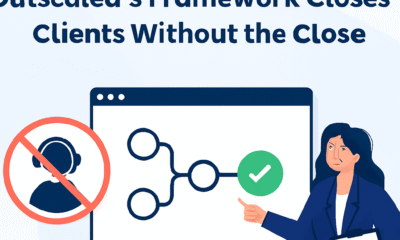Technology
5 Game-Changing Tips to Enhance Your LearnDash Quizzes

Designing quizzes that grab students’ attention, spark their interest, and guide them to real understanding is a mix of creativity and method. In online learning, quizzes have grown beyond basic tests. They’ve turned into strong ways to get students involved and learning. LearnDash and its solid features allow quizzes to become deep experiences—tough but satisfying, interactive but educational.
When designed with care and strategy, quizzes become more than just tests; they become moments of discovery. Whether your audience consists of busy professionals, enthusiastic schoolchildren, or lifelong learners, the structure and intent of a quiz significantly shape the learning journey.
What sets a quiz apart from the rest? How can you create one that sticks in people’s minds and helps them learn more? This post will look at five key things that can turn your quizzes into unforgettable learning tools. Let’s jump in and see how you can make every quiz a big step forward in online learning!
5 Essential Elements To Enhance Your LearnDash Quizzes
Quizzes are actually doing a good deal more than a knowledge test—their powers reside also in inspiring the learners/motivating students, where learning is solidified, too. That takes creating far more than that of q-and-a-style quiz answers. The greatest quiz inside LearnDash that does just challenge the students will keep on them engaged with it by making them not fall out-of-sight focused for leaving. It’s worth trying making five practical steps in support of your development to take the quizzes ahead.
-
Add Timed Quizzes for an Extra Boost
Timed quizzes are used for purposes other than imposing a time constraint on the learner; they are a very effective way of creating engagement, concentration, and motivation. With time being limited, the learner has to think fast, stay alert, and rely on their actual knowledge. This extra layer of challenge not only tests their knowledge but also keeps the experience exciting.
On a deeper level, timed quizzes recreate real-life scenarios where quick thinking is essential. Imagine a language learner applying grammar rules under the pressure of a ticking clock—just like they might in an actual exam. These quizzes go beyond testing knowledge; they train learners to stay composed and confident when time is tight, helping them tackle similar challenges with ease in the future.
With LearnDash Quiz Customization, setting up timed quizzes is simple. You can limit time per question or for the entire quiz. Plus, tools like Simple Course Timer by Uncanny Owl and LearnDash Advanced Quizzes give you even more control over timing. By tailoring time limits to match your learners’ skill levels, the difficulty of your questions, and your course objectives, you can create timed quizzes that are both effective and empowering.
-
Give Instant Feedback to Boost Learning
Feedback is effective in the process of learning. However, when it is immediate it becomes much more powerful. Why? Because it lets learners know what they did wrong as soon as possible and see the right answers while the question is fresh in their minds. This way, they learn faster but also retain the concepts well for the next assessments.
With LearnDash, you’ll be able to provide instant feedback for each question or for the quiz as a whole at the end. You could elaborate on a brief explanation of the wrong answer to clear up any misunderstanding.
Feedback could also show approval of the correct answer and encourage a student to continue with the topic. When a student answers a question correctly, a message such as, “Well done! You are doing great!” would be very encouraging. Prompt feedback helps students stay on track and reduces discouragement.
-
Make Learning Fun with LearnDash Gamification
Gamification is something of a game-changer for e-learning in the interest of boosting engagement. These include certificates, badges, and leaderboards, and, if used properly, it would make learning an interesting and game-like experience. The intrinsic motivation to achieve, excel, and enhance themselves will be a prime motivation to make the experience fulfilling and enjoyable.
With LearnDash, the teacher can reward students for their performance in quizzes with certificates and badges. This gives them something solid to celebrate their success with. Climbing up a leaderboard or earning a certificate for their effort can be very motivating to them.
For an even more customized alternative, plugins such as Multiple Certificate Pro allow preparing an individual certificate for a unique course, quiz, lesson, or group. This means learners are rewarded for each milestone they can achieve, thus keeping them motivated and proud of themselves. And if you look to really step up the gamification game, seeking the services of a LearnDash developer would be more than ideal. As your ideas could finally come to fruition and bring out an experience that learners would love.
-
Personalize the Experience with Adaptive Learning Paths
One approach doesn’t work for everyone in education. This is particularly true about quizzes. A great way of personalizing quizzes is to have it adaptable to the ability level of every learner. This gives every learner the appropriate support he needs for his learning journey, thus being productive and custom-fit.
For example, if a student struggles with certain questions, LearnDash lets you set rules to redirect them to previous lessons or extra resources for reinforcement. On the flip side, if a quiz feels too easy, advanced learners can be challenged with more complex material. This flexibility ensures that students feel supported, not overwhelmed or bored, while still being encouraged to grow.
An adaptive quiz adjusts to meet learners where they are, offering a unique experience that keeps them engaged, confident, and motivated to move forward. It’s a powerful way to make learning feel approachable while pushing students toward meaningful progress.
-
Add Save, Resume, and Retake Options for Greater Flexibility
Learning doesn’t always happen in a straight line, and life’s interruptions can make it hard for learners to finish a quiz in one go. That’s where save, resume, and retake features come in—they make quizzes more flexible and adaptable to fit different schedules and paces.
The save-and-resume option is especially handy for longer quizzes, particularly for busy professionals who may need to pause and come back later. This removes the pressure of completing everything in one sitting, allowing learners to return with a fresh focus and less stress.
Retake options are just as valuable, giving students the opportunity to learn from their mistakes and try again. Learners often perform better when they’ve had time to reflect and revisit challenging topics. You can even set specific conditions for retakes, like limiting the number of attempts or requiring a cooldown period between tries. These features create a forgiving and learner-friendly environment that helps students stay engaged and succeed on their terms.
Conclusion
Adding well-considered components to your LearnDash tests is about making the learning process richer and more interesting, not just about assessing knowledge. Some of its typical features are timed challenges, adaptive learning, rapid feedback, and gamification-features that make quizzes exciting tools urging students to learn more, build confidence, and drive them. The options of saving, resuming, and retaking the assignment present flexibility in learning for them to do things at their own pace without being pressured or having too much burden on the students.
These five important aspects can help make your quizzes better and also bring that learning environment in which your students can bloom. When these techniques are used, quizzes may be a fun and significant component of the educational process, motivating students to continue participating, investigate novel ideas, and push themselves.
Technology
Why AI Employee Tracking Alone Can’t Build a Thriving Company

Imagine running a small business where every keystroke, email, and coffee break is tracked by an algorithm. Sounds efficient, right? But when I helped a friend streamline her startup’s operations in 2025, we quickly learned that relying solely on AI employee tracking—like the best employee tracking software—can backfire. While tools like Controlio offer powerful insights into productivity, they miss the human spark that makes a company truly great. Let’s explore why AI tracking alone isn’t enough and what really drives a thriving workplace.
The Limits of AI Tracking: Numbers Over Nuance
AI employee tracking tools, like the Controlio app, are designed to boost efficiency by monitoring metrics such as time spent on tasks or app usage. They’re fantastic for spotting patterns—say, identifying when your team’s bogged down by repetitive work. But here’s the catch: they reduce people to data points. When my friend’s startup leaned too heavily on tracking software, her team felt like cogs in a machine, not valued contributors.
Research shows that excessive surveillance can tank morale. A 2024 Cornell study found employees under AI monitoring reported higher stress and lower productivity compared to those with human oversight. Why? Algorithms lack context. They can’t tell if someone’s late because they were helping a colleague or if a long email thread was a creative brainstorm. Over-reliance on AI risks alienating your team, stifling the very innovation you’re trying to foster.
Human Connection: The Heart of a Great Company
Great companies aren’t built on dashboards alone—they thrive on trust, collaboration, and shared purpose. I saw this firsthand when my cousin’s catering business hit a rough patch. Instead of doubling down on tracking tools, she hosted weekly team huddles to share ideas and celebrate wins. The result? Her staff felt heard, and turnover dropped by 30% in six months.
AI can’t replicate the empathy of a manager who notices a team member’s off day and offers support. It can’t spark the camaraderie of a spontaneous lunchroom chat that leads to a breakthrough idea. Building a strong company culture means prioritizing relationships over reports. Encourage open communication, mentorship, and team-building—elements no algorithm can quantify.
Creativity and Innovation: Beyond the Algorithm’s Reach
AI tracking excels at measuring output but struggles with intangibles like creativity and emotional intelligence. When I worked with a local design agency, we noticed their AI tool flagged “unproductive” hours spent sketching or brainstorming. Yet those moments birthed their best campaigns. Over-focusing on metrics can suffocate the creative freedom that drives innovation.
A 2025 McKinsey report highlights that companies fostering experimentation and collaboration outperform those obsessed with efficiency metrics. Give your team room to take risks—whether it’s prototyping a bold idea or debating a new strategy. Tools like Controlio can track time, but they can’t measure the spark of a game-changing idea born over coffee.
Trust vs. Surveillance: Striking the Right Balance
Constant monitoring erodes trust, and trust is the glue of any great company. Employees who feel watched like hawks are less likely to take initiative or share honest feedback. A Reddit thread from 2024 echoed this, with workers venting about AI tracking making them feel “on edge” and less loyal to their employers.
When my friend’s startup introduced transparent policies about how tracking data would be used—like improving workflows, not punishing pauses—her team relaxed. Use AI tools to empower, not police. Share insights with employees, involve them in decisions, and set clear boundaries. For example, use Controlio to optimize schedules, but pair it with regular check-ins to show you value their input, not just their output.
Ethical Concerns: Avoiding Bias and Burnout
AI isn’t neutral—it can amplify biases or push employees toward burnout. A 2025 Business Insider report noted that poorly designed AI tracking systems may unfairly flag certain groups, like remote workers, due to inconsistent data patterns. Plus, an overemphasis on productivity metrics can lead to exhaustion, with 60% of surveyed employees reporting stress from constant monitoring.
To counter this, regularly audit your AI tools for bias and ensure they align with your company’s values. Promote work-life balance with policies like flexible hours or mental health days. My friend learned this the hard way when her team’s morale dipped—she countered it with wellness programs, and productivity soared.
Final Note: Blend Tech with Heart for Lasting Success
AI employee tracking, like the Controlio app, is a powerful tool for streamlining operations, but it’s not a magic bullet. Great companies are built on trust, creativity, and human connection—qualities no algorithm can fully capture. My friend’s startup flourished when she balanced tech insights with genuine care for her team, proving that people, not just data, drive success.
In 2025, embrace AI as a helper, not a boss. Use tools to spot inefficiencies, but invest in mentorship, open dialogue, and a culture where employees feel valued. That’s the recipe for a company that doesn’t just survive but thrives. Ready to strike that balance? Start exploring smarter ways to blend tech and heart today.
Technology
“Duster SUV: Complete Guide to Features, Specs, Safety, and Buying Tips”

Introduction
The word Duster brings to mind a simple, sturdy SUV many people trust. This car feels practical and honest. It fits families, adventurers, and daily drivers alike. People praise its space, its simple tech, and its low cost to own. In this article, I explain what makes the Duster special. I use clear, short sentences that are easy to read. I give real facts, helpful tips, and plain advice. I show numbers where they matter and share trusted insights. Read on for design notes, engine choices, safety facts, buying tips, and six common questions. By the end, you will know whether this model suits your life and budget.
What it is
The Duster is a compact SUV that blends value with practicality. It started as a no-nonsense crossover people could afford. Over time, it grew more refined while keeping its core strengths. Today it comes in several versions for many markets. You can find models with mild-hybrid help or classic petrol engines. The Duster aims to offer a roomy cabin without high costs. It targets buyers who want a solid SUV without fancy frills. That clear purpose shaped its design and its price strategy. Many drivers see it as an honest car that gives you what you need.
Design and styling
The look of this compact SUV mixes toughness and neat lines. It keeps a broad stance and raised wheel arches. The front often shows a strong light design and simple grille work. Inside, the layout favors durable materials and sensible storage. The exterior has roof bars and protective cladding for outdoor use. Designers focused on useful features over delicate trims. That choice helps keep repair costs low over time. If you want flashy leather and soft touch everywhere, this might not be it. But if you want a rugged, honest SUV ready for trips, it fits the bill.
Engines and powertrains
You can pick from small petrol engines and mild-hybrid setups. Some markets also see a larger 2.0 petrol and 4×4 option. Engine output varies by region and trim level. The simplest petrol is easy to maintain and quite fuel friendly. The mild-hybrid choice helps with short town runs and saves fuel. For tougher terrain, a 4×4 option offers extra traction and control. Manuals, CVTs, and automatic options appear depending on model year. Always check exact engine details where you live before you buy. Each version balances performance and fuel economy differently.
Fuel economy and efficiency
This SUV can be quite frugal, depending on the engine you pick. Smaller petrols often return good fuel efficiency in mixed driving. Hybrid versions claim better urban economy and lower emissions. The mild-hybrid systems help reduce engine load at idle and in slow traffic. Real-world economy will change with load, terrain, and driving style. Drivers who favor calm acceleration often see the best numbers. If you plan long highway trips, choose an engine tuned for steady cruising. Official figures give a useful baseline when you compare trims.
Off-road capability and ground clearance
Raised ride height makes this model useful on rough tracks and muddy roads. Some trims list over 200 mm of ground clearance for easy approach. Four-wheel drive models include terrain selectors for snow, mud, and sand. The suspension is tuned for resilience rather than sporty handling. Protective skid plates help against rocks and bumps on trails. That setup gives confidence for weekend camping and farm access roads. Still, it is a compact SUV, not a heavy-duty truck. Match expectations to the terrain you’ll tackle most often.
Interior space and practicality
The cabin focuses on smart storage and easy cleaning for busy lives. Boot volume ranges from mid to large capacity, depending on trim and engine. With rear seats folded, the load area grows to take longer items. The double-floor and compartments help keep gear tidy on long trips. Front and rear passengers get sensible legroom for the class. Infotainment supports phone mirroring in many trims for maps and music. Materials lean toward durable plastics and simple switches for reliability. This makes the interior practical for family life and outdoor adventures.
Safety and ratings
Safety equipment varies by market and trim level. Many versions now come with driver aids like lane assist and emergency braking. Older models had fewer safety features, but recent upgrades improved this area. Buyers should look for multiple airbags, stability control, and strong crash ratings. Always compare the fitment of safety tech between trims before you buy. Choosing a version with active safety aids makes daily driving more secure. Families especially benefit from these modern protections.
Ownership and running costs
One big strength is the low cost of ownership compared to rivals. Insurance and repair parts tend to be cheaper for this model. Service intervals are reasonable and many mechanics know the platform. Fuel bills depend on engine and driving habits, but smaller engines keep costs down. Resale value varies by region and trim, so check local used prices. Warranty length also differs by country. If you plan to buy used, ask for full service history and check for rust or heavy off-road wear. Overall, the Duster aims to be affordable to run and repair.
Trim levels and options
Manufacturers offer a clear set of trims from basic to well-equipped. Basic trims give the essentials to keep the price low. Mid trims add nicer infotainment, alloy wheels, and comfort items. Top trims may include leather-effect seats and advanced driver aids. Some regions add unique packs like camping gear or cargo versions. You can often choose bar-style roof racks and protective mats. Decide which features you need before picking a trim. That saves money and avoids paying for extras you will not use.
How it compares with rivals
Against similar compact SUVs, the Duster wins on price and practicality. Some rivals offer fancier cabins or sharper handling. Others will have stronger dealer networks or better long-term resale. If you want rugged looks and simple tech, this model often leads. If you prefer premium fit and more silence inside, look at other brands. Compare boot size, fuel numbers, and safety kit when you shop. Test drives across a few models reveal which feels best for your needs.
Maintenance, tips, and common issues
Routine checks keep this SUV reliable for many years. Watch for common wear items like brake pads and suspension bushes. Keep the air filter fresh if you drive dusty roads often. For long trips, check belts and fluid levels before you leave. Choose genuine parts when possible, but good aftermarket parts can save money. If the car has a CVT, follow the service rules for transmission oil. Joining owner groups can give you tips on common fixes. These small steps help avoid surprises and control repair costs.
Customization and accessories
Owners often add roof racks for bikes and kayaks. Boot liners and mudflaps protect the paint and the interior. For camping, simple tents and sleep packs make trips easier. All-weather mats help keep the cabin clean in winter. Some dealers sell protection packs with skid plates and light guards. Choose only tested accessories that fit factory mounts. Proper accessories raise the car’s usefulness without harming safety. A small investment in the right bits makes the vehicle far more versatile.
Environment and hybrid tech
Newer mild-hybrid and hybrid setups reduce fuel use in town. The hybrid option often lets the engine rest for short electric-only runs. This suits stop-and-go traffic in cities well. Hybrid tech also helps reduce emissions and fuel bills. Still, the fuel gains depend heavily on how you drive. Long highway trips may show less benefit than urban driving. If your commute is mostly city, a hybrid variant can cut costs. Always review real-world test results to compare engines before buying.
Best use cases and who should buy it
The Duster fits families who want space and low costs. It serves people who enjoy weekend trips off the beaten track. Small business owners like cargo versions for city deliveries. First-time SUV buyers get easy driving and affordable upkeep. Buyers who want full luxury or sporty handling should consider other models. If you value honest design, big boot space, and rugged style, this one is sensible. Matching the trim to your needs ensures good value for the money.
Conclusion — is it right for you?
In short, the Duster blends value, space, and rugged practicality. It is not the quietest or plushest cabin in its class. But it will carry people, luggage, and pets without fuss. If low running costs matter, it can be a smart choice. Read the spec sheet carefully in your country before you buy. Test drive the same engine and trim you plan to purchase. Check local prices and dealer support for your area. If you like simple, practical design and honest value, this SUV may fit your life.
FAQs
Q1 — What is the best engine for daily driving?
A small petrol or mild-hybrid often works best for daily use. These choices give low city fuel use. They feel calm and save money on regular runs. If you carry heavy loads often, choose the bigger petrol. For mixed town and highway trips, a mild-hybrid balances economy and comfort.
Q2 — How much boot space does it offer?
Boot space depends on trim and engine choices. Typical figures start around mid-hundreds of litres. Folding the rear seats adds a lot of cargo room. Official brochures list exact litres for each version. Always confirm the details for the model in your region.
Q3 — Is the four-wheel drive model worth it?
Four-wheel drive helps if you face mud, snow, or steep tracks. It adds weight and usually lowers fuel economy. For mostly city driving, a 2WD version is often enough. Choose 4×4 if you need traction on rough ground frequently.
Q4 — Are parts and servicing expensive?
Parts and servicing tend to be affordable compared to premium rivals. Many mechanics know the platform well. Warranty coverage varies by country. Regular servicing and modest care keep costs predictable.
Q5 — How safe is the model?
Safety kit and crash scores differ by year and market. Some older models had fewer aids, but newer versions include more. Look for emergency braking, lane assist, and multiple airbags. Confirm the exact features on the trim you plan to buy.
Q6 — Should I buy new or used?
New gives full warranty and the latest gear. Used saves money but needs careful checks. Ask for service records and inspect for off-road wear. If budget is tight, a certified pre-owned unit can be a balanced choice.
Technology
What is Zivechatz? Full Review, Features, and How to Use It
-

 Technology3 years ago
Technology3 years agoIs Camegle Legit Or A Scam?
-

 Travel3 years ago
Travel3 years agoNEW ZEALAND VISA FOR ISRAELI AND NORWEGIAN CITIZENS
-

 Technology3 years ago
Technology3 years agoRNDcoin: Korea’s first blockchain project and a world-class cryptocurrency
-

 Uncategorized3 years ago
Uncategorized3 years agoAMERICAN VISA FOR NORWEGIAN AND JAPANESE CITIZENS
-
Lifestyle1 year ago
A Guide to Silverdaddies: What You Need to Know
-

 Fashion1 year ago
Fashion1 year agoGoda Perfume Reviews: Is It Worth Your Investment?
-

 Health3 years ago
Health3 years agoHealth Benefits Of Watermelon
-

 Home Improvement9 months ago
Home Improvement9 months agoArtificial Grass Designs: Perfect Solutions for Urban Backyards















